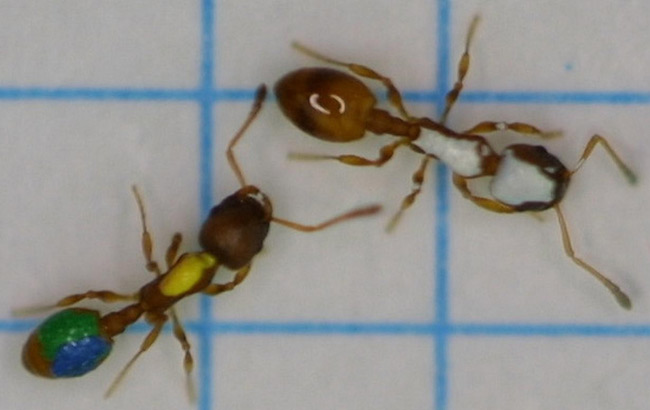Ant School: The First Formal Classroom Found in Nature

Ants teach other ants how to find food using a poking and prodding technique called "tandem running," a new study reveals.
Researchers say the experiment reveals the first non-human example of formal instruction between a teacher and pupil in which there is two-way feedback and an adjustment of the course curriculum.
When female worker ants of the species Temnothorax albipennis set out for food, they often find another ant to make the journey with. If the second ant doesn't know where to find food, the leader teaches her through tandem running.
The process is slow. The follower pauses every once and a while—creating a gap between it and the leader—to search for landmarks. When she''s ready to continue, the follower catches up and taps the leader on the hind legs.
Mutual feedback
Researchers carefully analyzed the ants' movements and determined that the process is controlled by mutual feedback between the two gatherers. If the gap between them gets too large, the leader slows down and the follower speeds up. The opposite occurs if the gap becomes too small.
Studies have shown that bumblebees can learn to find food by watching others, and that chimpanzees can teach their mates how to get at food with a stick. But the researchers say this is the first non-human example of bidirectional feedback teaching—where both the teacher and pupil modify their behavior to provide guidance at a rate suitable for the pupil's abilities.
Get the world’s most fascinating discoveries delivered straight to your inbox.
Getting directions from a lead ant helped the followers find their way to food much more quickly—on average 201 seconds with help versus 310 seconds without. But showing the way is costly for the lead ants, which can move nearly four times faster on their own.
It takes longer partly because the followers make large loops as they go, probably in search for landmarks to find their way back with.
The next generation of leaders
So why do the leaders take the time?
"They are very closely related nest mates and their society as a whole will benefit," study leader Nigel Franks of the University of Bristol told LiveScience.
In fact, the follower's return path was generally faster and straighter than its leader's before the tandem run. Often, the followers learn the path so well that they become leaders and help spread the time-saving information throughout the colony.
Sometimes a lead worker will simply sling a follower on her back and march to food. This method works three times faster than tandem running. Carried ants, however, do not learn the way, possibly because they're upside down and backwards.
This research is detailed in the Jan. 12 issue of the journal Nature.
- Secret Weapons: The Defenses of Small Creatures
- Creatures of the Wild: The Best of Your Amazing Images
- Scientists Teach Sparrows to Sing Backward
- Scientists: You Learn Without Knowing It
- Ants Use Antibiotics to Fight Pests


